| Solar eclipse of September 12, 2053 | |
|---|---|
 Map | |
| Type of eclipse | |
| Nature | Total |
| Gamma | 0.314 |
| Magnitude | 1.0328 |
| Maximum eclipse | |
| Duration | 184 sec (3 m 4 s) |
| Coordinates | 21°30′N 41°42′E / 21.5°N 41.7°E |
| Max. width of band | 116 km (72 mi) |
| Times (UTC) | |
| Greatest eclipse | 9:34:09 |
| References | |
| Saros | 145 (24 of 77) |
| Catalog # (SE5000) | 9626 |
A total solar eclipse will take place at the Moon's ascending node of the orbit on Friday, September 12, 2053 with a magnitude of 1.0328. A solar eclipse occurs when the Moon passes between Earth and the Sun, thereby totally or partly obscuring the image of the Sun for a viewer on Earth. A total solar eclipse occurs when the Moon's apparent diameter is larger than the Sun's, blocking all direct sunlight, turning day into darkness. Totality occurs in a narrow path across Earth's surface, with the partial solar eclipse visible over a surrounding region thousands of kilometres wide.
Related eclipses
Solar eclipses 2051–2054
This eclipse is a member of a semester series. An eclipse in a semester series of solar eclipses repeats approximately every 177 days and 4 hours (a semester) at alternating nodes of the Moon's orbit.[1]
| Solar eclipse series sets from 2051–2054 | ||||
|---|---|---|---|---|
| Descending node | Ascending node | |||
| Saros | Map | Saros | Map | |
| 120 | April 11, 2051 Partial |
125 | October 4, 2051 Partial | |
| 130 | March 30, 2052 Total |
135 | September 22, 2052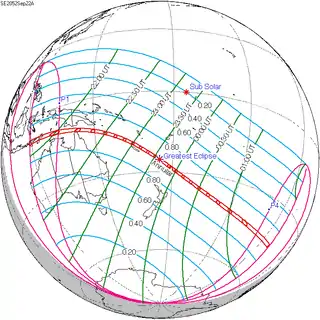 Annular | |
| 140 | March 20, 2053 Annular |
145 | September 12, 2053 Total | |
| 150 | March 9, 2054 Partial |
155 | September 2, 2054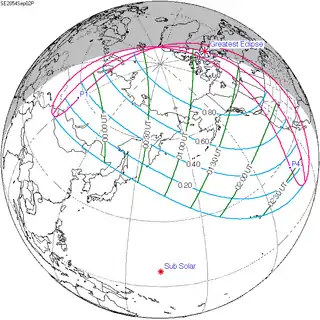 Partial | |
Saros 145
This solar eclipse is a part of Saros cycle 145, repeating every 18 years, 11 days, 8 hours, containing 77 events. The series started with a partial solar eclipse on January 4, 1639, and reached a first annular eclipse on June 6, 1891. It was a hybrid event on June 17, 1909, and total eclipses from June 29, 1927, through September 9, 2648. The series ends at member 77 as a partial eclipse on April 17, 3009. The longest eclipse will occur on June 25, 2522, with a maximum duration of totality of 7 minutes, 12 seconds. All eclipses in this series occurs at the Moon's ascending node.
| Series members 10–32 occur between 1801 and 2359 | ||
|---|---|---|
| 10 | 11 | 12 |
 April 13, 1801 |
 April 24, 1819 |
 May 4, 1837 |
| 13 | 14 | 15 |
 May 16, 1855 |
 May 26, 1873 |
 June 6, 1891 |
| 16 | 17 | 18 |
 June 17, 1909 |
 June 29, 1927 |
 July 9, 1945 |
| 19 | 20 | 21 |
 July 20, 1963 |
 July 31, 1981 |
 August 11, 1999 |
| 22 | 23 | 24 |
 August 21, 2017 |
 September 2, 2035 |
 September 12, 2053 |
| 25 | 26 | 27 |
 September 23, 2071 |
 October 4, 2089 |
 October 16, 2107 |
| 28 | 29 | 30 |
 October 26, 2125 |
 November 7, 2143 |
 November 17, 2161 |
| 31 | 32 | 33 |
 November 28, 2179 |
 December 9, 2197 |
 December 21, 2215 |
| 34 | 35 | 36 |
 December 31, 2233 |
 January 12, 2252 |
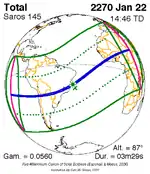 January 22, 2270 |
| 37 | 38 | 39 |
 February 2, 2288 |
 February 14, 2306 |
 February 25, 2324 |
| 40 | ||
 March 8, 2342 | ||
Metonic series
The metonic series repeats eclipses every 19 years (6939.69 days), lasting about 5 cycles. Eclipses occur in nearly the same calendar date. In addition, the octon subseries repeats 1/5 of that or every 3.8 years (1387.94 days). All eclipses in this table occur at the Moon's ascending node.
| 21 eclipse events, progressing from south to north between July 1, 2000 and July 1, 2076 | ||||
|---|---|---|---|---|
| July 1–2 | April 19–20 | February 5–7 | November 24–25 | September 12–13 |
| 117 | 119 | 121 | 123 | 125 |
 July 1, 2000 |
 April 19, 2004 |
 February 7, 2008 |
 November 25, 2011 |
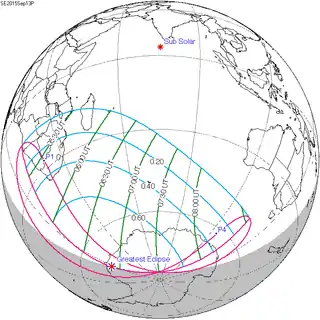 September 13, 2015 |
| 127 | 129 | 131 | 133 | 135 |
 July 2, 2019 |
 April 20, 2023 |
 February 6, 2027 |
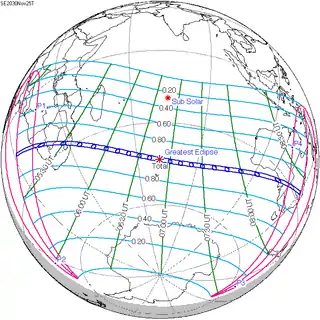 November 25, 2030 |
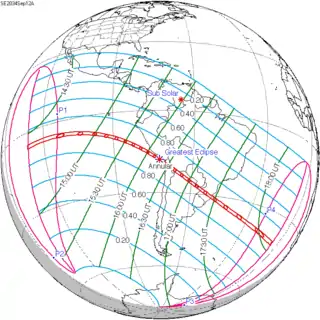 September 12, 2034 |
| 137 | 139 | 141 | 143 | 145 |
 July 2, 2038 |
 April 20, 2042 |
 February 5, 2046 |
 November 25, 2049 |
 September 12, 2053 |
| 147 | 149 | 151 | 153 | 155 |
 July 1, 2057 |
 April 20, 2061 |
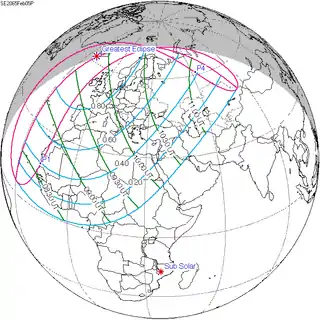 February 5, 2065 |
 November 24, 2068 |
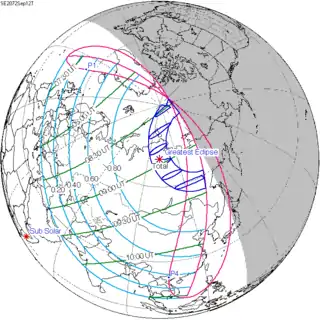 September 12, 2072 |
| 157 | 159 | 161 | 163 | 165 |
 July 1, 2076 |
||||
References
- ↑ van Gent, R.H. "Solar- and Lunar-Eclipse Predictions from Antiquity to the Present". A Catalogue of Eclipse Cycles. Utrecht University. Retrieved 6 October 2018.
- Earth visibility chart and eclipse statistics Eclipse Predictions by Fred Espenak, NASA/GSFC
.jpg.webp)

